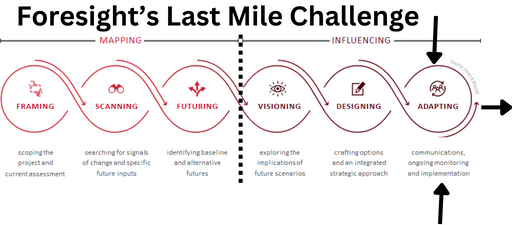One of the biggest changes I’ve seen in foresight practice in more than three decades of work is the shift to more emphasis on implementation. At Houston Foresight, we call this the influencing phase, which follows the first phase of mapping the potentials. In short, once you’ve mapped the futures, how do you influence them – what might you do?

We’ve based our process on the six competencies of the APF Foresight Competency Model. Other futurists might call it something different, but most of us do some version of this. In my client work, we keep being asked to go deeper in terms of more specific and detailed recommendations on what to do. At first, and even today to some extent, it feels like we are encroaching on the client’s territory – we’re in the space where you might think they would be “taking it from here.” Nonetheless, since our goal is to make foresight more useful, we take the journey.
The very last step of adapting is where the final “translation” happens. We’re practically inside the organization now, metaphorically speaking. As external consultants, it’s difficult to sufficiently grasp the culture and politics. [An organizational futurist partner is ideal here.] Futurists typically have not built a deep tool kit here. The change managers are here. The Organizational Development (OD) people are here. But why not us? I’m doing research with colleague Mina McBride on this last mile challenge. How can we futurists help bridge this important gap? – Andy Hines

Andy – I just finished your post on the last mile and the reluctance of the client to “take it from here”. You are absolutely right.
Having spent my career on the client side for many years, before spending my last four or so years learning and practicing Foresight, I think I might offer one perspective on why the client doesn’t take the reins. I am sure there are many for every client is different. Often the Foresight practitioners who are truly “worth their salt”, are transparent and perhaps even over-communicative with their clients. They go through the Foresight steps, showing the data and expertise which drives the nature of the work and analysis, culminating in the creativity and innovation of the scenarios. In the ideal case, rare but happening more frequently as the value of Foresight is realized, the client is a part of the process. But very often, the client will let the practitioners just continue with the designing and adapting stages; often thinking “let’s just let the experts do it – its too hard to jump in now”. The Foresight experts must now become experts in the client’s organization, its politics, its constraints, its competitors, its environment. Yes- all those things which the practitioner counts on the client to provide.
Understandable but disappointing. The truly unfortunate part of the entire situation is, if it is only the practitioners who perform the work, even in the adapting stage, there is no client “buy-in”. Then even the most remarkable and groundbreaking work will remain untouched, in a file on a server somewhere, akin to the end of the movie Raiders of the Lost Ark.